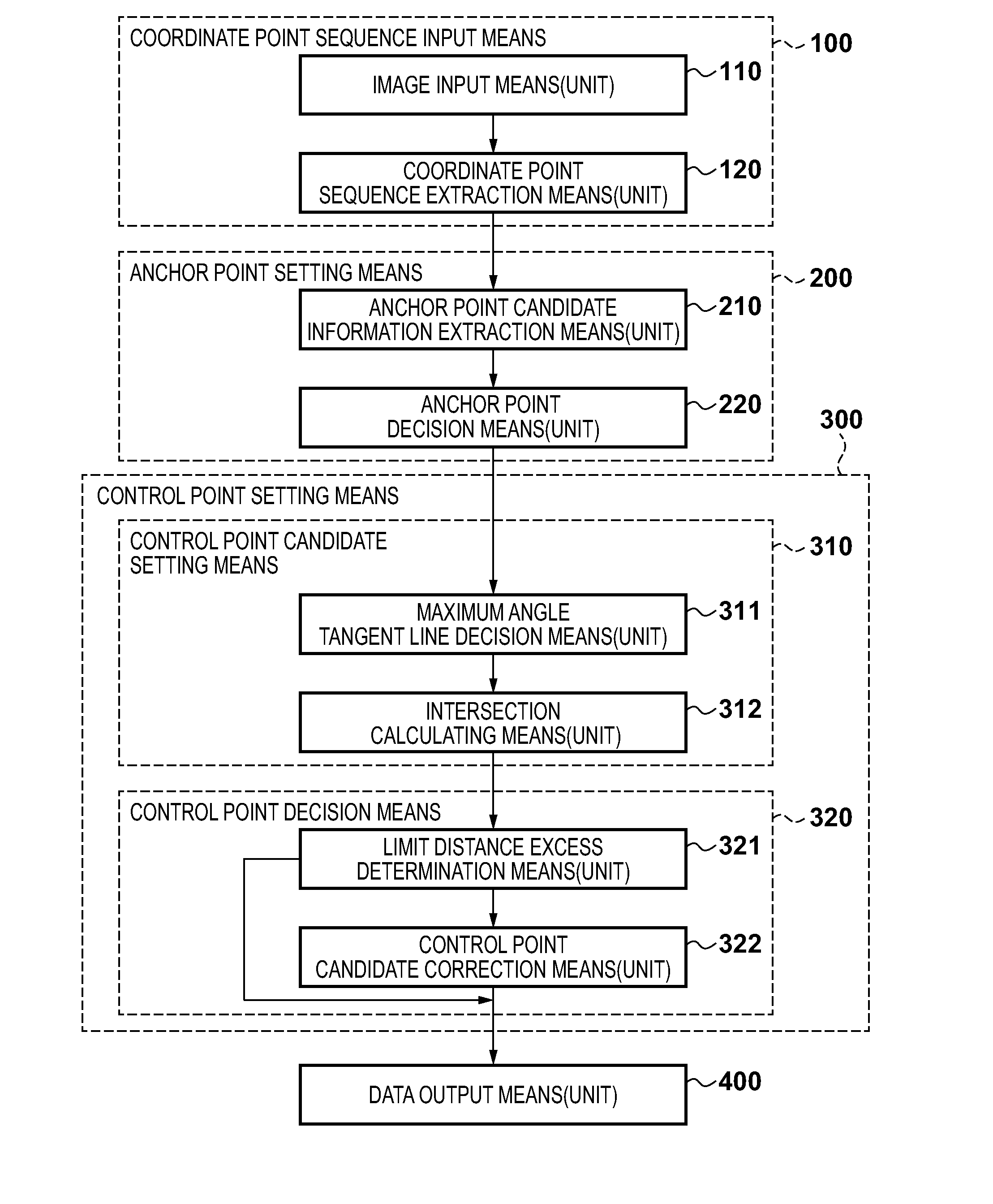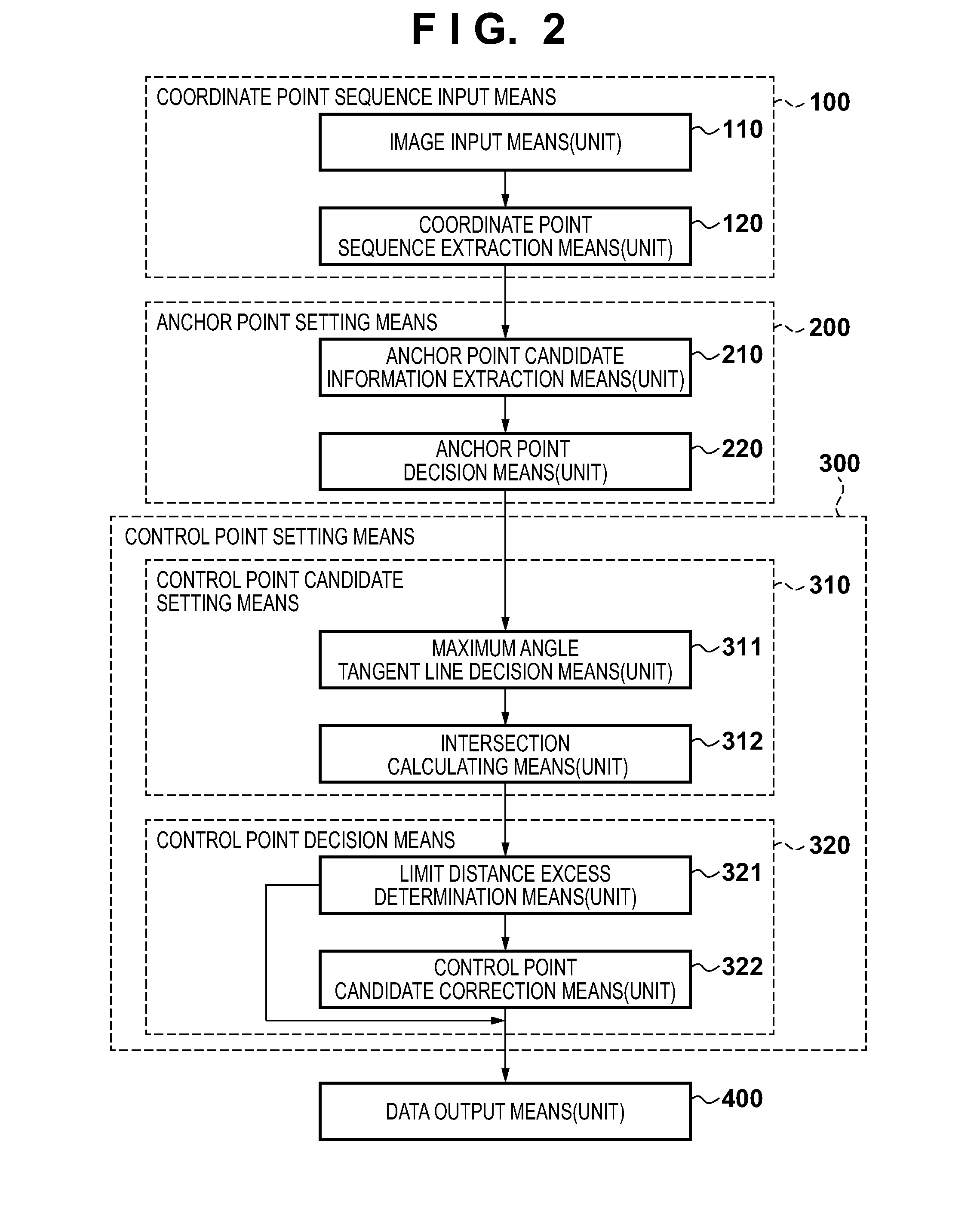Image processing method, image processing apparatus, and program
a technology of image processing and image data, applied in the field of image processing technology, can solve the problems of deterioration of image quality, decreased processing speed and extraction of excessive dividing points, and low approximation precision, and achieve the effect of high precision
- Summary
- Abstract
- Description
- Claims
- Application Information
AI Technical Summary
Benefits of technology
Problems solved by technology
Method used
Image
Examples
embodiment 1
[0045]Below is a description of embodiments of the present invention with reference to the attached drawings. However, it should be noted that the constituent elements described in the embodiments are to be taken as examples only, and the technical scope of the present invention is defined by the appended claims, and is not intended to be limited by the individual embodiments described below.
[0046]Example of Configuration of Image Processing Apparatus
[0047]An example of a configuration of an image processing apparatus according to the present embodiment will be described with reference to the block diagram in FIG. 1. The image processing apparatus may be achieved by a general purpose computer or a peripheral apparatus such as a multifunctional copying machine (MFP). In FIG. 1, a CPU 7 is a processing unit that performs overall control of the apparatus. The procedure of a flowchart described in the present embodiment is realized by the CPU 7 executing a program that describes this pr...
embodiment 2
[0107]In Embodiment 1, in anchor point decision processing, elimination processing is performed if another anchor point candidate exists within two coordinate points before and after an anchor point candidate of interest. However, in a case in which coordinate points included between anchor point candidates are separated by three points or more, even if a redundant anchor point candidate exists, such a point cannot be eliminated. According to the present embodiment, if a sequence is partitioned into a unit approximation section in a range that can be represented by a quadratic curve, it is possible to perform approximation processing without failure, and thus further anchor point candidate elimination may be performed.
[0108]In view of this, in the present embodiment, the priorities of adjacent anchor point candidates are compared, and then elimination processing is performed. Further, if elimination is performed by comparing anchor point candidates, the result of the elimination is ...
embodiment 3
[0115]In Embodiment 1, in anchor point candidate extraction processing, anchor point candidate information is extracted by tracking the coordinate point sequence extracted in step S120. At this time, it is necessary to calculate the angle of a coordinate point sequence for attributes such as “inflection point” and “critical point” according to which extraction is performed using a change in angle, and thus as shown in FIG. 18A, determination is performed on every other point.
[0116]However, at this time, even in a case of the same coordinate point sequences, different extraction results will be obtained in a case in which a coordinate point sequence 1 in FIG. 18A is determined and a case in which a coordinate point sequence 2 in FIG. 18A is determined, and thus the final approximation results may not match in the two cases.
[0117]In order to handle this, in anchor point candidate information extraction processing in Embodiment 1, “inflection point” and “critical point” determination i...
PUM
 Login to View More
Login to View More Abstract
Description
Claims
Application Information
 Login to View More
Login to View More - R&D
- Intellectual Property
- Life Sciences
- Materials
- Tech Scout
- Unparalleled Data Quality
- Higher Quality Content
- 60% Fewer Hallucinations
Browse by: Latest US Patents, China's latest patents, Technical Efficacy Thesaurus, Application Domain, Technology Topic, Popular Technical Reports.
© 2025 PatSnap. All rights reserved.Legal|Privacy policy|Modern Slavery Act Transparency Statement|Sitemap|About US| Contact US: help@patsnap.com



